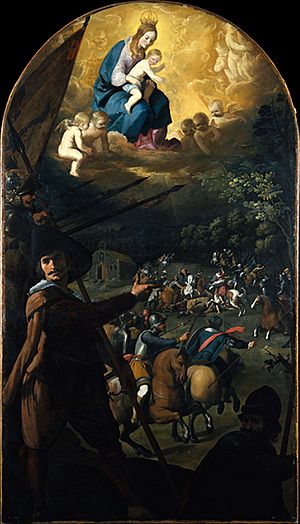Battle of Jerez facts for kids
Quick facts for kids Battle of Jerez |
|||||||
|---|---|---|---|---|---|---|---|
| Part of the Reconquista | |||||||
 A 17th-century depiction of the battle |
|||||||
|
|||||||
| Belligerents | |||||||
| Moors | |||||||
| Commanders and leaders | |||||||
| Álvaro Pérez de Castro infante Alfonso (ambiguous; see text) |
Ibn Hud | ||||||
| Strength | |||||||
| 1,000 knights 2,500 infantry |
Unknown | ||||||
| Casualties and losses | |||||||
| Unknown | Unknown | ||||||
The Battle of Jerez was an important fight that happened in 1231. It took place near the city of Jerez de la Frontera in southern Spain. This battle was part of the Reconquista, a long period when Christian kingdoms in Spain fought to take back land from Muslim rulers.
In this battle, the troops of King Ferdinand III of Castile and León fought against the forces of Emir Ibn Hud. Ibn Hud was the ruler of a Muslim kingdom called a taifa, located in Murcia. The Castilian (Christian) army was led by Prince Alfonso de Molina, who was King Ferdinand's brother. He was helped by Álvaro Pérez de Castro. Some stories say that Castro was actually the main leader.
This battle is often seen as a turning point. It greatly weakened Ibn Hud's power. After his defeat, a new leader named Muhammad I rose to power. He would later start the Nasrid dynasty in Granada.
The Battle Unfolds
In April 1231, King Ferdinand III of Castile and León sent out a group of mounted raiders. These raiders were called algaras. They started their journey from Andújar and headed towards Córdoba, causing damage along the way.
- They attacked Palma del Río, and many people there were killed.
- Then, they continued towards Seville, but they went around it.
- The expedition moved on to Jerez and Vejer.
- They set up camp near the Guadalete River.
The main goal of this raid was probably to distract Emir Ibn Hud. It worked! Ibn Hud chased after the Christian raiders and caught up with them. However, in the battle that followed, his troops were badly defeated. They lost many soldiers, and the Christians were able to leave with lots of stolen goods.
This raid also helped the Christians in another way. While Ibn Hud was busy, an army led by Archbishop Rodrigo Jiménez de Rada was able to capture Quesada without much trouble. King Ferdinand had ordered this attack in April as well.
Who Led the Castilian Army?
It's not completely clear who was in charge of the Castilian expedition. We know for sure that Álvaro Pérez de Castro was there. He might have been the main commander.
Some old Christian records mention an "infante Alfonso." An infante is a prince. This could mean either:
- The King's brother, Alfonso de Molina.
- The King's son, who would later become King Alfonso X.
The Primera Crónica General, a history book from 1906, said it was Alfonso de Molina. A historian named Derek William Lomax also thought it was Molina in 1978.
However, another historian, Gonzalo Martínez Diez, believed in 2000 that it was the king's son. This is because a passage described the infante as "very young" (muy moço). It also said he was under the protection of Álvaro Pérez de Castro, who led the troops.
Julio González, a Spanish historian, knew about both ideas. But in 1946, he thought it was very unlikely that Ferdinand's son, who would have been only nine years old, was involved in a battle. Still, a book about Alfonso X from 2003 places him with Álvaro Pérez de Castro during this raiding campaign, including the battle.
What Happened After?
King Alfonso X, who was a historian himself, called this operation a cavalgada. This means a large-scale raid carried out by mounted soldiers. He wrote about how important the Battle of Jerez was:
"It is fitting that you who are hearing this story know that the thing in the world that most broke the Moors, why they had to lose Andalusia and the Christians gain it from them, was this battle of Jerez. That is how the Moors were shattered. They could never again muster the daring nor the effort which they had previously against the Christians, such was the level of the shock and fear they experienced on that occasion."
Historian Gonzalo Martínez Diez agrees that this defeat definitely weakened Ibn Hud's power. In April 1232, a new leader appeared: Muhammad ibn Nasr. He declared himself emir in Arjona. Muhammad ibn Nasr would eventually become the first ruler of the Nasrid dynasty in Granada.
According to Julio González, Ibn Hud might have been more focused on fighting the last of the Almohads. The Almohads were another Muslim group. Ibn Hud took Gibraltar from them in October 1231, finally pushing them out of the Iberian Peninsula. He then tried to capture Ceuta in 1232.
Ibn Hud's rule really started to fall apart about a year later, between October 1232 and October 1233. He faced problems both from inside and outside his kingdom:
- A rebellion in Seville tried to make an alliance with Muhammad ibn Nasr.
- The Christians captured Úbeda.
- The Almohads managed to hold onto Ceuta.
Another sign of Ibn Hud's weakening power was a later raid on Cádiz. This city was attacked fiercely by Christian soldiers in 1234–1235. This time, there was no one to stop them.
The Battle of Jerez was later written about and celebrated by a Spanish writer named Adolfo de Castro in the 1800s.
See also
 In Spanish: Batalla de Jerez para niños
In Spanish: Batalla de Jerez para niños

